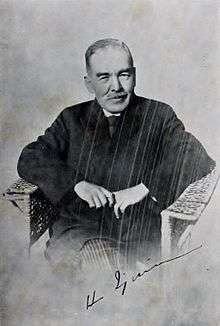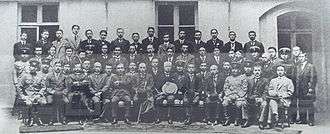Ijuin Hikokichi
| Baron Ijuin Hikokichi | |
|---|---|
| 伊集院彦吉 | |
 | |
| Minister of Foreign Affairs | |
|
In office 19 September 1923 – 7 January 1924 | |
| Prime Minister | Gombei Yamamoto |
| Preceded by | Gombei Yamamoto |
| Succeeded by | Keishiro Matsui |
| Personal details | |
| Born | 1864 |
| Died |
26 April 1924 (aged 59) Tokyo |
Ijuin Hikokichi (伊集院彦吉; 1864 – 26 April 1924) was a Japanese diplomat and politician who served as minister of foreign affairs and Japanese ambassador to Peking.
Early life
Hikokichi was born in 1864.[1][2]
Career
Hikokichi was appointed consul at Chefoo in China in 1893.[3] He served again in China as consul general at Tientsin from 1901 to 1907.[3] He was appointed ambassador to Pekin in 1908.[4] On 4 September 1909, he signed the Japan-China Agreement concerning Kando as the Japanese ambassador to the Ching Empire in Beijing.[5] During the Chinese revolution broke out in October 1911, together with then foreign minister Uchida Yasuya, he argued for the provision of support to the Ching government during the 1911 Chinese revolution.[6] His term as ambassador to Pekin lasted until 1913.[3]
Then, he was appointed the Japanese ambassador to Rome in 1916 and in office until 1920.[1] During his tenure, he was one of the leading members of Japanese delegation at the Paris Peace Conference in 1919.[5] Hikokichi is described as a conservative ambassador.[7]

On the other hand, then prime minister Hara Takashi wanted Hikokichi to search for European institutions of public information when the latter was ambassador and a Versailles delegate.[8] Ijuin reported that the best way to create an influential information bureau was to coordinate all information sources, including army, navy and finance ministry.[8] Eventually, a public information office (Gaimusho Johobu) in the ministry of foreign affairs was established on 13 August 1921, and Hikokichi was appointed its head.[8][9] Then he served as governor-general of Kwantung Leased Territory in northeastern China for one year.[10] He was appointed on 8 September 1922, replacing Isaburo Yamagata as the governor-general.[11] Hikokichi was in office until 19 September 1923.[12][13]
Then he was appointed foreign minister on 19 September 1923 to the second cabinet of Gombei Yamamoto,[14][15] replacing him who also assumed the role of foreign minister briefly from 2 to 19 September.[14] Hikokichi was replaced by Keishiro Matsui on 7 January 1924 when a new cabinet was formed by Keigo Kiyoura.[15]
Personal life
Hikokichi married to Okubo Toshimichi's daughter.[1] And Hikokichi was brother-in-law of Makino Nobuaki.[1]
Death
Shortly after his removal from the office, Hikokichi died of neuralgia in Tokyo in April 1924.[5][16]
References
- 1 2 3 4 Hui-Min Lo (1 June 1978). The Correspondence of G. E. Morrison 1912–1920. CUP Archive. p. 873. ISBN 978-0-521-21561-9. Retrieved 8 January 2013.
- ↑ Wendy Palace. The British Empire and Tibet 1900–1922. New York: Routledge. p. 176. Retrieved 30 August 2013.
- 1 2 3 Denis Twitchett; John K. Fairbank (2008). The Cambridge History of China; Republican China, 1912-1949, Part 1. Cambridge University Press. p. 156.
- ↑ "The Diplomatic Corps in Peking". Moss Valley. Retrieved 8 January 2013.
- 1 2 3 "1909 China-Japan agreement concerning Koreans in Chientao". Yosha Research. Retrieved 8 January 2013.
- ↑ John K. Fairbank; Albert Feuerwerker (24 July 1986). The Cambridge History of China: Volume 13, Republican China 1912–1949. Cambridge University Press. p. 92. ISBN 978-0-521-24338-4. Retrieved 8 January 2013.
- ↑ Li Narangoa; R. B. Cribb (2003). Imperial Japan and National Identities in Asia: 1895–1945. Psychology Press. p. 74. ISBN 978-0-7007-1482-7. Retrieved 10 January 2013.
- 1 2 3 Matsumura, Masayoshi (19 November 2001). "Japan Calling: The Origins of the Ministry of Foreign Affairs Information Department in the Early 1920s". The Asiatic Society of Japan. Retrieved 11 January 2013.
- ↑ Ian Hill Nish (2002). Japanese Foreign Policy in the Interwar Period. Greenwood Publishing Group. p. 24. ISBN 978-0-275-94791-0. Retrieved 11 January 2013.
- ↑ "Foreign Concessions and Colonies". World Statesmen. Retrieved 8 January 2013.
- ↑ "1922 events". World War II Database. Retrieved 8 January 2013.
- ↑ "Japan's Colonial Administration 1895-1931". Japanese History. Retrieved 8 January 2013.
- ↑ "1923 events". World War II Database. Retrieved 8 January 2013.
- 1 2 "Second Yamamoto Cabinet" (PDF). Japanese History. Retrieved 8 January 2013.
- 1 2 "Japan Ministers". Indiana University. Retrieved 8 January 2013.
- ↑ "News from Japan". The Straits Times. Tokyo. 28 April 1924. Retrieved 10 January 2013.